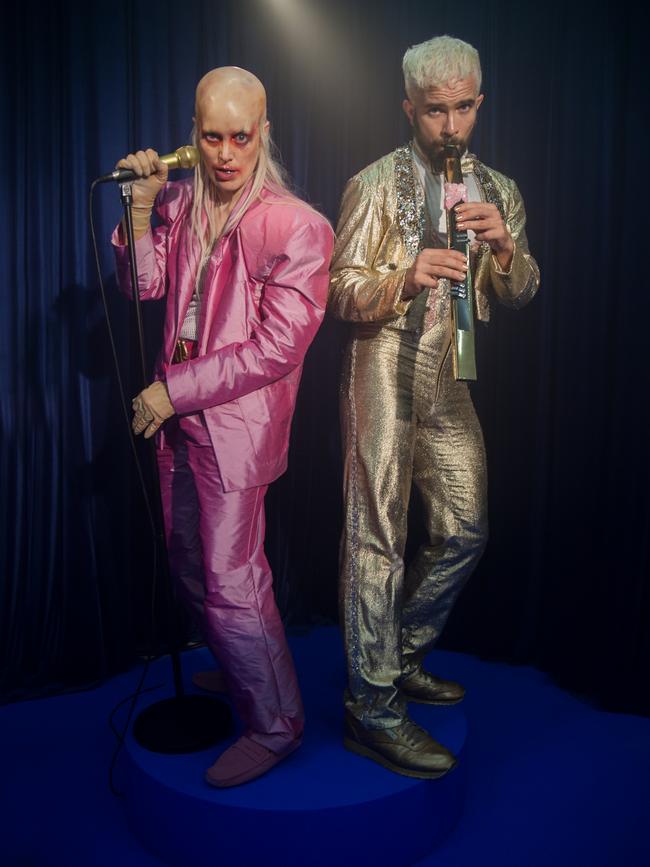Interview: Karin Dreijer aka Fever Ray on Radical Romantics and working with Olof again
Swedish artist Karin Dreijer, aka Fever Ray, on masks, identity, and returning to the cosy creative partnership that powered the genre-shaping electronic duo The Knife.

Throughout its existence, Swedish electronic music duo The Knife showed no interest in following the usual path of fame.
Composed of Karin and Olof Dreijer, the siblings – whose work became known and revered in indie music communities about two decades ago – made a habit of appearing in promotional images wearing papier-mache beaked prostheses to mask their identities.
When coupled with wintry backdrops and the darker tones that dominated the duo’s 2006 masterpiece Silent Shout, it sent a clear message of icy aloofness that often matched the sounds they created.
Those controlled images extended to the stage, too: on the first occasion the pair toured internationally, the performers were obscured behind a translucent screen and backlit by batteries of flashing lights. The two humans up there were shown in silhouette, as they sang, played drums, and prodded at electronic equipment.
Uncomfortable with being the centre of attention, the artists made these decisions to remain distant and unknowable to their audience, even as their shared star grew, particularly among readers of the US indie music website Pitchfork, whose editors would later nominate Silent Shout as its album of the year.
Though they preferred the shadows to the spotlight, the siblings were adept at producing deeply affecting soundscapes that mixed digital with analog instrumentation. “Even in the wake of such pollutants as international success, ubiquitous acclaim, and frequent imitation, The Knife have found a way to keep their name meaning something remarkably unique and pure,” noted writer Lindsay Zoladz in 2013.
The duo was just as capable of writing dancefloor-ready bangers – as exemplified by the dizzying, pinballing sounds stacked in We Share Our Mother’s Health and Neverland – as it was capable of crafting moody, moving arrangements such as Marble House and the opening title track of Silent Shout. The latter song’s trio of rumbling, ominous bass notes continues to elicit goosebumps today, having influenced countless electronic producers and composers in the 17 years since its release.
As well, the siblings demonstrated a regular preference for using vocal processing to pitch-shift and obscure the singer’s gender. Thanks to this technology, each of The Knife’s four albums contained falsetto, baritone and everything in between, in a voice that often felt androgynous and post-human.
The pitch-shifting effect was yet another mask, and when Karin launched a solo project in 2009 under the name Fever Ray – on a debut album whose electronic production was an easy continuation of the sounds heard on Silent Shout – the effects followed, in a stunning collection inspired by the singer-songwriter’s alienating, isolating experience of motherhood.
As Fever Ray, a second album titled Plunge eventually followed in 2017, and a third collection is nearing release – yet for longtime followers of their art, Dreijer’s decision in 2019 to identify as non-binary, using they/them pronouns, contained few surprises, for during The Knife’s 15-year career, which ended amicably in 2014, gender had always been a fluid concept in the artistic output.
In promotional images and music videos for the upcoming Fever Ray release, titled Radical Romantics, Dreijer has adopted an unusual and somewhat frightful visage that blends performance art with office workwear; one striking shot sees the artist clad in a grey suit and placing their head in a photocopier situated in long grass near a swamp. Make of that what you will.
Here is a remarkable person, creating art for the public, who one suspects has prized anonymity and the ability to separate their professional and personal life – or at least that has always appeared to be the case. In a recent video interview with Review, Dreijer smiles at the question when asked, before confirming that was the intent all along.
“When we did The Knife tour in 2006, both Olof and me were like, ‘Oh, we can’t go up on the stage – no, no, no. We don’t want to be there’,” they recall. “And then (director) Andreas Nilsson, who we worked with then, said, ‘But you can have masks; it’s fine. We will have these curtains in front of you, and nobody will even notice you’re there.’ It felt like we could try this, so that’s how it started.
“But I think now, the characters are more about portraying different emotions,” says Dreijer, 47, of the newest Fever Ray persona. “I think they’re very much more like mental states. They don’t have names, really. We have some work names, just to sort them out – but then, after we’ve done something (with a character), they can also blend together.”
After a thoughtful pause – one of many during a fascinating conversation about identity – Dreijer says, “I think I’m a bit of a shapeshifter myself. I don’t think of myself as in one (body); that I look the same every morning. I wake up, and if I look in the mirror, it’s like, ‘Oh, OK. That’s you!’ ”
They laugh, then say, “I think I’m somewhere else, maybe, and how this thing that carries around myself … I don’t know. I’m trying to be nice to it, but it’s not of any importance; but when performing, I think it’s very important. Who is it, really, who’s going to perform on this tour that is coming up? Who will perform the tracks? That is something that we are working on, still.”
It is morning in Sweden when we connect in mid-January; Dreijer wears a black hoodie and short-cropped blond hair while sitting on a couch inside a studio in Stockholm, which is situated beside a similar space owned by their brother.
“When I came back from the last tour (in 2018), we started to build a new studio, me and Olof,” they say. “He moved back from Berlin to Stockholm; we built one studio each, next to each other. I just started working, and then the pandemic came. We didn’t have a lockdown (in Sweden), but we were supposed to work from home. And since there was no other people here, I could go to the studio every day, which was amazing. I just kept on working, and then it turned out to be many songs.”
On Radical Romantics, the siblings and former bandmates have reunited to co-produce four songs, which also happen to be the first four tracks, titled What They Call Us, Shiver, New Utensils and Kandy, respectively.

“It’s been fun to work with him again,” Dreijer says with a smile. “We go in and out, and listen to each other’s stuff, and give feedback: ‘Hey, what do you think about this?’ It’s very nice.
“We know each other very well, so we don’t have to explain so much what we feel and think about music,” they say. “The directions that I give him for a track, it’s like, ‘I want it to be colourful, sparkling here and there, and make it fruity!’ That’s how we talk, and we understand; we have a language that both of us know, which makes things easy.”
Of their long-running fascination with pitch-shifting vocal effects, in what has undoubtedly become a hallmark of their sound across both projects, Dreijer says, “I think processing vocals is really part of who I am in music. Even if I do things in my ‘natural voice’, there is still a lot of processing: you choose another microphone, you choose how you fix it slightly afterwards [in production]; maybe I switch up the format a little bit to make it sound more ‘itchy’. I think it’s always about finding a voice that goes along with the story that I want to tell, or the atmosphere that I want to set.”

With the newest Fever Ray album, the artist has extended their mastery of experimental electronic music and alternative pop in yet another compelling direction. Taken together, with and without their brother, Dreijer has slowly but surely crafted a singular recording canon whose influence has been rightly celebrated in the past two decades. Performing, though, has rarely been easy for them.
In August 2018, when cancelling a series of shows, Fever Ray wrote on Twitter: “Many of you know already that I’ve been struggling with general anxiety and panic attacks for a long time. For seven years I did not enter the stage, for five years I did not enter an airplane (…) The last month though has been rough and my anxiety has started to escalate. I will now have to take a break from touring to take care of myself and restore my health.”
The upcoming run of concerts – led by whichever Fever Ray performance persona Dreijer and their team decide makes the most sense in the context of the new songs – will mark their first shows in 4½ years, and offer a test run for more to come, perhaps.
One thing has been missing, though: an Australian tour. With both The Knife and Fever Ray, Dreijer has only ever undertaken limited tours of Europe and the US, and about 30 dates in those territories have been booked for this year so far.
“I’ve never been to Asia; I’ve never been to South America. I would love to go to Australia some day, but we’ll just see if it works,” they say with a smile that gives nothing away.
As a celebrated artist with more than 700,000 monthly listeners on Spotify alone, Fever Ray seems like an easy programming fit for the likes of Tasmanian winter event Dark Mofo or OHM, a new “festival of other music”, which will debut at the Brisbane Powerhouse this month.
But with three album releases in 14 years, Dreijer is clearly the sort of artist who isn’t to be rushed, and who marches to the beat of their own drum. In effect, their patient and painstaking approach to creating art that matters is living proof of the maxim that good things come to those who wait.
Radical Romantics by Fever Ray is released on March 10 via Rabid Records.




To join the conversation, please log in. Don't have an account? Register
Join the conversation, you are commenting as Logout